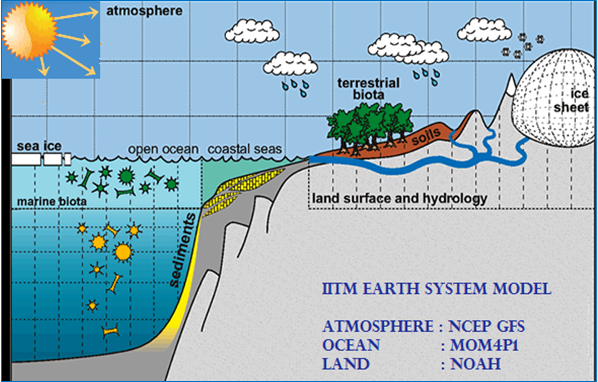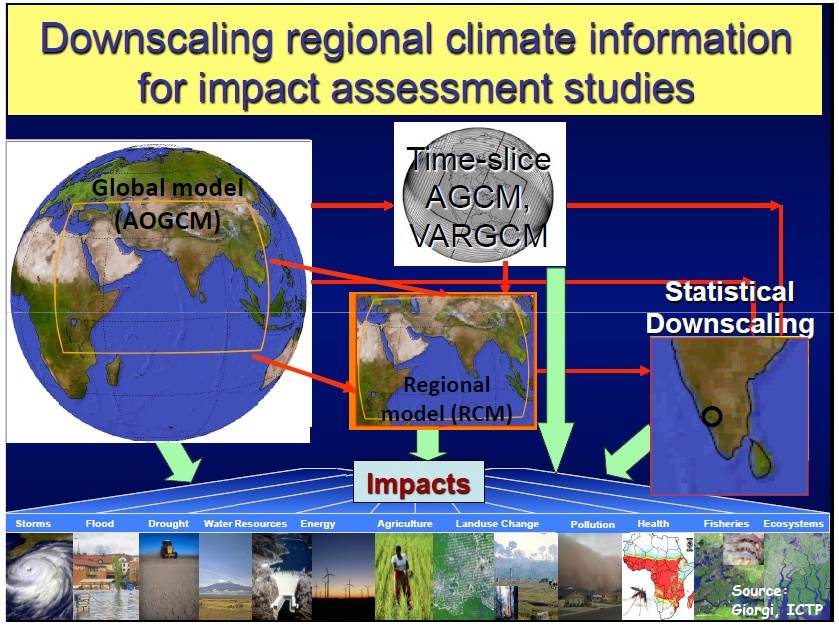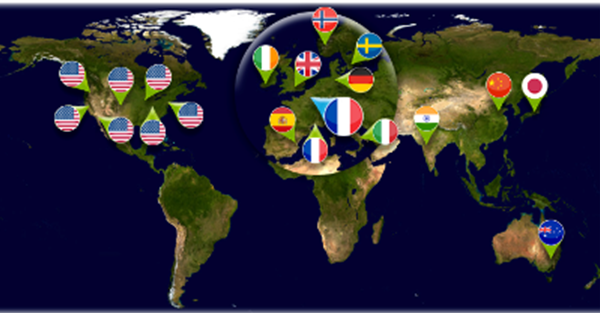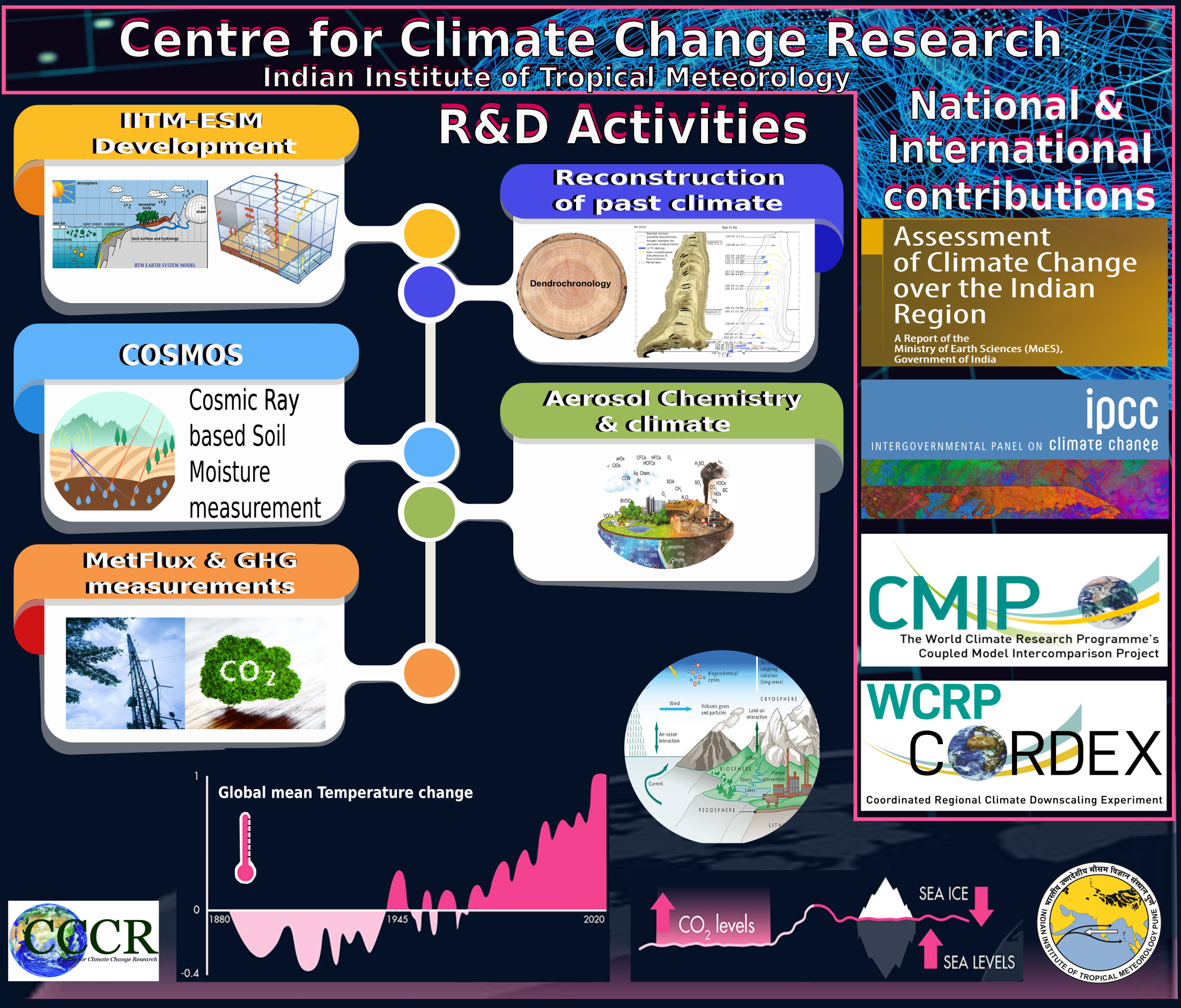- CCCR aim to better understand the science of climate
change over the Tropics and enable improved assessments of the
regional climate responses to global climate change... More
- CCCR has the mandate of developing an Earth System Model (ESM) and to make the regional climate projections, in addition to work on Paleoclimatology and Greenhouse Gas (GHG) measurements. More
- The International Conference on Regional Climate (ICRC)-CORDEX conference will focus on discussions and ideas for the way forward and CORDEX contributions to the WCRP.... More
-
 Development of IITM Earth System Model... More
Development of IITM Earth System Model... MoreDevelopment of IITM Earth System Model
Reliable predictions of the Asian monsoon rainfall to climate change are extremely important because more than one-fifth of the world’s population heavily depends on monsoon. Climate models have challenges in representing monsoon precipitation and its variability over Asian region, especially over India. To address the long-term critical need in India for a climate model that would provide reliable future projections of monsoon rainfall, the Centre for Climate Change Research (CCCR) has developed an Earth System Model, IITM-ESM. The development of IITM-ESM is based on the Memorandum of Understanding between Ministry of Earth Sciences (MoES), Govt. of India and the National Oceanic and Atmospheric Administration (NOAA), USA, through which the coupled ocean–atmosphere model, Climate Forecast System version 2 (CFSv2, Saha et al., 2014) was implemented for seasonal prediction at IITM. The IITM-ESM has emerged through the transformation of CFSv2, the seasonal monsoon prediction model into a long-term climate model. The first version of IITM ESM (ESMv1) showed significant improvements in the simulation of sea surface temperature and captures dominant modes of climate variabilities and their links with the Indian summer monsoon. In a recent version (IITM-ESM2.0), further improvements are incorporated in order to obtain a radiatively-balanced global climate modeling framework, which is required for predicting long-term climate change. Additionaly, radiative effects of natural and anthropogenic aerosols are incorporated in IITM-ESM by specifying time-varying 3-dimensional fields of aerosol optical properties. The land-use, land-cover changes are implemented by incorporating the land harmonization dataset (LUH2) in IITM ESM. The IITM-ESM shows improvements in simulating sea ice distribution, ocean biogeochemistry and mean precipitation over Asian monsoon region. Significant improvement is the better representation of mean state over Indo-Pacific region and the improvement in the large scale circulation pattern including Walker and Hadley circulations and its associated teleconnections. The ENSO-Monsoon teleconnections, a present weakness in many of the climate models is realistically represented in IITM ESM. IITM will be contributing to the forthcoming Inter-Governmental Panel of Climate Change (IPCC) 6th phase of Coupled Modeling Inter-comparison Project (CMIP6) with DECK, historic and GMMIP simulations, first from India.
Source : Provide URL
Date : -
 Generation of High-resolution Simulations of 20th Century Climate and Future Climate Projections through involvement in CORDEX.. More
Generation of High-resolution Simulations of 20th Century Climate and Future Climate Projections through involvement in CORDEX.. MoreGeneration of High-resolution Simulations of 20th Century Climate and Future Climate Projections through involvement in CORDEX
A good understanding of the Indian summer monsoon variability in the present and future time scales would enrich the information available for policy makers and stakeholders for informed decision making. However for such an assessment, the global climate projections available from the Coupled Model Intercomparison Project (CMIP) using existing state-of-the-art coupled atmosphere-ocean general circulation models (AOGCMs) need to be downscaled at high spatial resolution to resolve the complexities of the monsoon and other hydrological processes over regional scales. With this objective the Centre for Climate Change Research (CCCR) at IITM is actively involved in the generation of regional climate change scenarios for Indian monsoon region by participating in the World Climate Research Programme (WCRP) initiative: COordinated Regional climate Downscaling Experiment (CORDEX), by dynamical downscaling of regional climate over the large domain covering South Asia using high resolution (50 km) Regional Climate Models (RCMs). CCCR, IITM is leading the South Asia component of CORDEX. Dr. R. Krishnan is a member of the CORDEX Science Advisory Team (SAT). The CORDEX South Asia datasets are based on simulations carried out at IITM, as well as from other partner institutions in Germany, Sweden, and Australia. A high-end data server has been set up for data archival and dissemination of the CORDEX South Asia data sets, through the CCCR web-portal. This climate data portal presently hosts available important meteorological variables such as rainfall, surface air temperature, sea level pressure, surface specific humidity, surface winds and surface radiation from five RCMs. These variables are available on daily and monthly time scales for the historical period (1950-2005) and for the future projection (RCP for 2006-2100). These datasets are being published on the CCCR-IITM Earth System Grid Federation (ESGF) climate data server set up for dissemination of high resolution climate information, which is essential for better understanding of regional climate change and for developing appropriate adaptation strategies
Source : Provide URL
Date : -
 Implementation of an Earth System Grid Federation (ESGF) data node for dissemination of CORDEX South Asia and CMIP6 datasets... More
Implementation of an Earth System Grid Federation (ESGF) data node for dissemination of CORDEX South Asia and CMIP6 datasets... MoreImplementation of an ESGF data node for dissemination of CORDEX SA and CMIP6 datasets
CCCR-IITM has developed an Earth System Grid Federation (ESGF) data node for archival, management, retrieval and dissemination of CORDEX South Asia and CMIP6 datasets. ESGF is an international collaboration for the software that powers using a system of geographically distributed peer nodes, most global climate change research, notably assessments by the IPCC. The dissemination of high resolution climate information published on the CCCR-IITM ESGF climate data server will be very useful for better understanding of regional climate change and for developing appropriate adaptation strategies for countries within South Asia.
Source : Provide URL
Date :
-
 The COordinated Regional Downscaling EXperiment (CORDEX) is a
diagnostic model intercomparison project (MIP) in CMIP6.
More
The COordinated Regional Downscaling EXperiment (CORDEX) is a
diagnostic model intercomparison project (MIP) in CMIP6.
More
-
 Advanced School on Earth
System Modelling (ESM) during 18-27 July, 2016 at IITM, Pune,
India..
More
Advanced School on Earth
System Modelling (ESM) during 18-27 July, 2016 at IITM, Pune,
India..
More
-
 Workshop on Climate
Change and Regional Impacts over South Asia during 28-29 July,
2016 at IITM, Pune, India..
More
Workshop on Climate
Change and Regional Impacts over South Asia during 28-29 July,
2016 at IITM, Pune, India..
More













